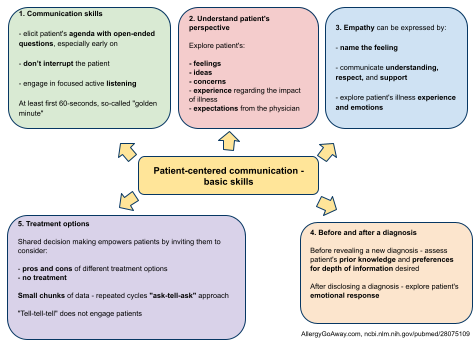Patient-centered communication: what are the basic skills?
Communication skills needed for patient-centered care include:
- eliciting the patient's agenda with open-ended questions, especially early on
- not interrupting the patient
- engaging in focused active listening
Practice this at least in the first 60-seconds, the so-called "golden minute".
Understand patient's perspective
Understanding the patient's perspective of the illness and expressing empathy are key features of patient-centered communication.
Understanding the patient's perspective entails exploring the patient's:
- feelings
- ideas
- concerns
- experience regarding the impact of the illness
- expectations from the physician

Patient-centered communication - basic skills (click here to enlarge the image).
Empathy
Empathy can be expressed by:
- naming the feeling
- communicating understanding, respect, and support
- exploring the patient's illness experience and emotions
Before and after a diagnosis
Before revealing a new diagnosis, the patient's prior knowledge and preferences for the depth of information desired should be assessed.
After disclosing a diagnosis, physicians should explore the patient's emotional response.
Treatment options
Shared decision making empowers patients by inviting them to consider:
- pros and cons of different treatment options
- no treatment
Instead of overwhelming the patient with medical information, small chunks of data should be provided using repeated cycles of the "ask-tell-ask" approach. Using "tell-tell-tell" does not engage patients.
Example:
1. Ask permission to start a conversation
3. Ask what the patient thinks about their health
4. Ask questions to find out what the patient already knows
5. Tell the patient information in a way that is easy to understand
6. Gauge the patient’s understanding by asking questions after you tell
What Is “Ask, Tell, Ask”? video:
References:
Patient-Centered Communication: Basic Skills. Hashim MJ. Am Fam Physician. 2017 Jan 1;95(1):29-34.
https://www.ncbi.nlm.nih.gov/pubmed/28075109
The 10 Building Blocks of Primary Care - “Ask Tell Ask” Sample Curriculum - UCSF
Ask-Tell-Ask: Simple Technique Can Help Hospitalists Communicate Difficult Messages http://buff.ly/2jeNVIN
- eliciting the patient's agenda with open-ended questions, especially early on
- not interrupting the patient
- engaging in focused active listening
Practice this at least in the first 60-seconds, the so-called "golden minute".
Understand patient's perspective
Understanding the patient's perspective of the illness and expressing empathy are key features of patient-centered communication.
Understanding the patient's perspective entails exploring the patient's:
- feelings
- ideas
- concerns
- experience regarding the impact of the illness
- expectations from the physician
Patient-centered communication - basic skills (click here to enlarge the image).
Empathy
Empathy can be expressed by:
- naming the feeling
- communicating understanding, respect, and support
- exploring the patient's illness experience and emotions
Before and after a diagnosis
Before revealing a new diagnosis, the patient's prior knowledge and preferences for the depth of information desired should be assessed.
After disclosing a diagnosis, physicians should explore the patient's emotional response.
Treatment options
Shared decision making empowers patients by inviting them to consider:
- pros and cons of different treatment options
- no treatment
Instead of overwhelming the patient with medical information, small chunks of data should be provided using repeated cycles of the "ask-tell-ask" approach. Using "tell-tell-tell" does not engage patients.
Example:
1. Ask permission to start a conversation
3. Ask what the patient thinks about their health
4. Ask questions to find out what the patient already knows
5. Tell the patient information in a way that is easy to understand
6. Gauge the patient’s understanding by asking questions after you tell
What Is “Ask, Tell, Ask”? video:
References:
Patient-Centered Communication: Basic Skills. Hashim MJ. Am Fam Physician. 2017 Jan 1;95(1):29-34.
https://www.ncbi.nlm.nih.gov/pubmed/28075109
The 10 Building Blocks of Primary Care - “Ask Tell Ask” Sample Curriculum - UCSF
Ask-Tell-Ask: Simple Technique Can Help Hospitalists Communicate Difficult Messages http://buff.ly/2jeNVIN
Comments
Post a Comment